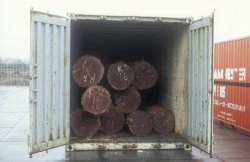Dutch elm disease (DED) first appeared in the north-west of Europe about 1910. Between 1914 and 1919, several Dutch scientists carried out influential research on the cause of the disease. Then in the late 1920s Dr Tom Peace of the British Forestry Commission began to monitor its rapid spread to the United Kingdom.
The first epidemic caused losses of between 10 and 40 per cent of elms in various European countries. But by the 1940s this first epidemic died down, and in 1960 Dr Peace was able to write that "unless it completely changes its present trend of behaviour it will never bring about the disaster once considered imminent".
However, such a change did come in the late 1960s with the beginning of a second and far more destructive outbreak of the disease. Forestry Commission research showed that the new outbreak of DED was caused by an entirely different, far more aggressive species of DED fungus that had been imported into Britain on elm logs  from Canada.
from Canada.
Pictured is a container of rock elm (Ulmus thomasii) imported with Dutch elm disease and Hylurgopinus rufipes larvae.
What followed was the catastrophic epidemic once feared by Dr Peace, which has killed tens of millions of elm trees across the UK.
Studies of the new DED fungus showed that it differed from the original fungus in almost all its important biological properties. The two pathogens were eventually described as separate species:
Find out more about historical and current Dutch elm disease in central and southern Britain, Cornwall and East Anglia and Scotland and north-west England.